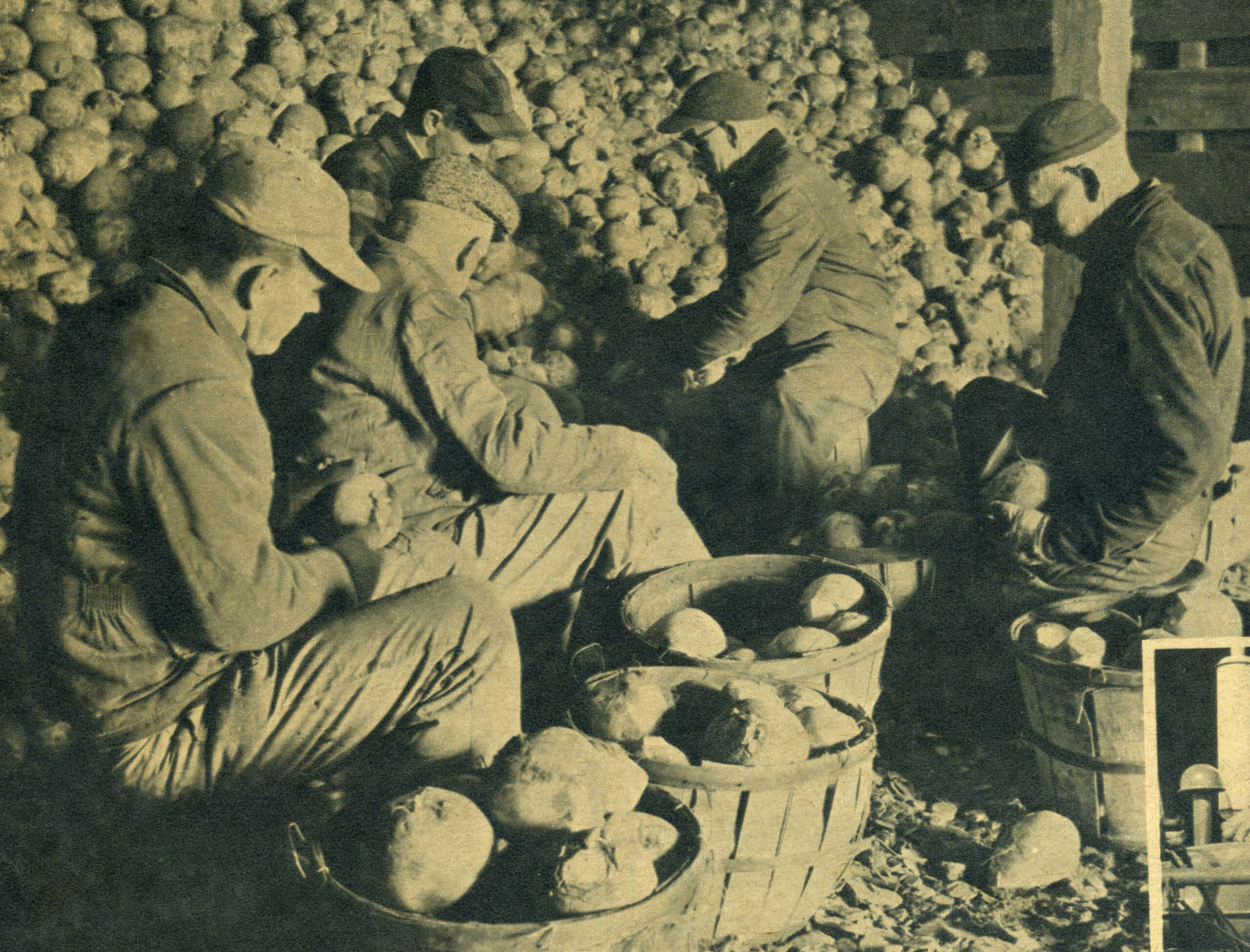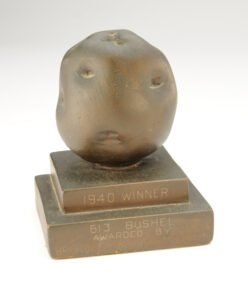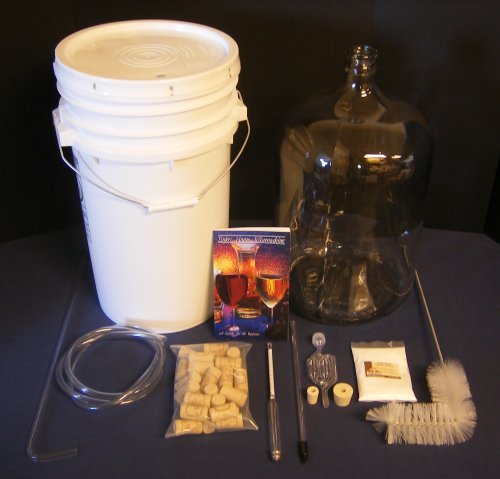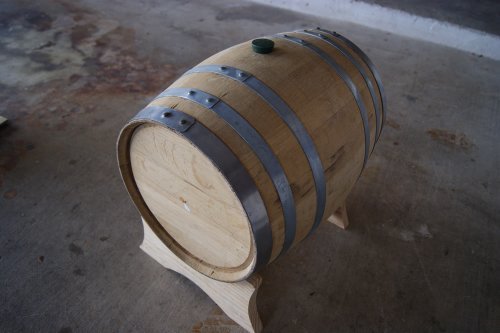Long Acres Farm and Westport Rivers Vineyard and Winery
Long Acres Farm, Hix Bridge Road / Westport Rivers Vineyard and Winery
From award winning potatoes to award winning wine

Smith brothers of Long Acres Farm
John Smith, who arrived in Westport from Scotland, purchased this property of 110 acres located near Cadmans Neck in 1882. For the next 40 years he raised cattle, planted corn, potatoes, and turnips. His three sons – William, John and Stuart – continued the farming tradition.
The farm was named Long Acres because of the considerable distance from its most northerly point to its most southerly point.
The farm was noted as an exceptionally well managed operation. The Smith brothers worked as a family team, thus avoiding the financial burden of hiring additional labor. Farming activities included:
Chickens
10 acres of turnips
10 acres of squash
50 acres of hay
75 acres of corn
20 acres of pastureland
One hundred head of cattle
In 1975 Bob Smith, the third generation to farm Long Acres, noted the pressures on local farms: politics, disease, the cost of gas to fuel 30 pieces of farm equipment, inflation, and recession. “Our overhead is just too much.”
Long Acres Farm feels pinch of economy, August 5, 1975
One hundred head of Holstein cows shuffled out of the barn, they may be up for auction soon. The last crop of turnips may have just been planted. The Smiths cannot afford to grow potatoes anymore.”
In 1980, the Smith family was offered a large sum of money to develop their farm into a 65-unit housing lot. Fortunately, the Smiths decided to sell to another farmer, Bob Russell, who with his wife Carol, established Westport Rivers Vineyard and Winery.

Smith Farm Potato Trophy
Bronze potato award
In 1940, the Smith family of Long Acres farm was awarded this bronze potato in recognition of a record-breaking production of 613 bushels of potatoes on a single acre.
Winter on Long Acres Farm – March 10, 1963
Walk into the yard at Long Acres Farm, Westport, and say “Your name must be Smith” to any man that you meet and odds are you will be told “I’m one of them.” This is not surprising; Long Acres Farm has been in the family for three generations and the Smiths are all over the place …….. Tending to the dairy herd, the poultry, the potatoes, the turnips, the oats, the wheat, the rye, and the silage corn.
Long Acres Farm began when a stout-hearted young Scotsman named John Smith bought the farm in 1883 and began to clear brush ……. And without much machinery to ease his back either. Today, Long Acres Farm is one of the last general farm today in this area ……. General that is, not a specialized dairy or poultry farm or truck farm.
The biggest enemy of the farm today is the scarcity and the wages of the men needed to run it. The Smiths – Fathers, Brothers, Sons – all pitch in to run the farm, keep the costs in the Family labor. And, because the crop of the Smiths keeps pace with the other crops on the farm, the 120-acre home farm and outlying land can be turned into a profitably diversified and efficiently mechanized business. Five tractors plus mechanically abled hired men to operate the potato harvester, chopper, grain combine, manure spreaders, trucks and other tools of modern farming to make Long Acres Farm a happy exception to the usually declining lot of general farms.
Machines help, but Long Acres Farm, like all good farms, remains a happy haven for people who love hard work, a group that fortunately include all the Smiths. Fortunately for the rest of us, too; for all the gadget ridden life we lead, we still depend on the Smiths and their fellow farmers across the nation for the food we eat.
By: John H. Ackerman, Sunday Editor
Westport Rivers Vineyard and Winery
Information provided by Bob and Carol RussellSo, where does the winery fit in? This decision was partly based upon the “insidious gift” Carol gave Bob in a 1971 Christmas gift – a wine making kit. The gift prompted Bob to make wine making a serious hobby. Bob first made wine from grapes from the Providence and Boston distributor food markets. But being curious and serious about wine, he had to learn about grape growing, In 1978 Bob and Son Rob (who now heads up the winery in Westport) planted 100 grape vines of 10 different varieties across the street from 1892 Horten Street on land owned by the Russell’s. Out of this, Bob learned that growing grape vines was not a simple and easy thing.
In 1982 Bob and Carol began this process of entering the wine-growing business. Why?
- “In the blood” – Carol’s family in 1929 had bought the historic winery Germania Wine Cellars in Hammondsport, New York, which produced a nationally celebrated sparkling wine
- A continuation of their heartfelt mission to save the working landscape of local small farming, especially in New England which is one of the most densely populated regions in the United States.
- To fulfill their sense of stewardship of land and people their agricultural product would be grapes and their product would be fine wine grown and made in New England which had never been done before.
- To take Bob’s serious hobby to the next level as a small family agricultural business.
In 1982, after searching the globe for the perfect place to produce a quality wine, they chose Westport, Massachusetts where the climate is similar to the climate in Burgundy, France. Their bold vision and daring tactic s proven to be revolutionary for New England where people doubted that fine wines could be grown. Westport was chosen for one overriding reason: On Horseneck Road, about 3 miles south of Hixbridge Road there was a man, Jim Richards, who was growing about 2 acres of Chardonnay grapes. That convinced Bob and Carol that vinifera grapes could be grown in Westport.
In November of 1982, they said to themselves to forget going around the world in a sailboat and by the 110 acres of the Smith Family’s “Long Acre Farm” which had been their farm since about 1895 when John Smith immigrated from Scotland to New England. In a newspaper article filed in the Westport Public Library, the farm was cited as the most profitable farm in Massachusetts. During the early 1980’s Bob, William and David Smith decided to sell the farm. They had it subdivided for about 50 houses by a surveyor. When Bob and Carol bought the farm most Westport residents thought they bought it to build the houses.
Most of the farm buildings were in a state of repair or destruction. There were several places around the farm where they could construct a new winery but they decided the dairy barn was the best site. Renovating both the barn and the farmhouse would honor the historic aspects of the farm. Then, they decided to set up a base of operations and chose the small barn which is the first building on the laneway to the dairy barn. While working on that barn, Bob was approached by Son Rob if he could join the effort. Rob had an Associate degree from Wentworth Institute of Technology, was working as a carpenter and decided he wanted to work as a farmer instead. Bob’s comment in reply was that Rob could but he would have to learn how to grow grapes. In order to do this, Bob called Willie Frank who owned a winery in New York State and the person to whom Bob had placed an order of 44,000 vines of Chardonnay, Riesling and Pinot Noir to be delivered in 1986. Willie told Bob that his Son, Fred Frank, was the vineyard manager for Villa Banfi on Long Island and he thought that Frank might need some extra help. Fred agreed and Rob spent one year on Long Island learning how to grow grapes.
On the laneway to the winery, Bob and Carol bought the two residential houses from the Smith Families. They then planned to overhaul the dairy barn and hired a carpenter who after one day trying decided that re-construction was impossible. This was also confirmed by an architect. In discussing this with George Medeiros and his Sons, Michael and Stephen, Bob learned that there was a company in New York State that repaired old barns. Their salesman came to Westport at Bob’s request and said that his company could restore the barn. The company would come to Westport with its crew and not leave the area until the restoration was complete, which would be about two weeks. The crew was comprised of one older gent and 14 young men and they did the job because the older gent had a “feel’ on restoring buildings. This idea of renovating old buildings pleased all the Russell Family since they had already renovated a 350-year-old home in Dighton. They valued keeping the history of a place alive, such the Grifenhagen Family had also done in Hammondsport with Germania Wine Cellars.
In addition to the dairy barn being made into a winery, the buildings that had to be levelled and removed were two chicken coops, a repair shop and a potato cellar. The potato cellar was to the west of the farmhouse and south of the winery and required about 30 truckloads of gravel and topsoil to fill the space. To restore the farmhouse, Carol hired an architect, Kathryn Duff, and a local builder, Cody Camozzi, to do the renovation. This building is now the “Company Store”.
The planting of 44,000 vines ordered from Vinifera Wine Cellers were received in 1986. What did they plant? Chardonnay, Pinot Noir and Riesling. These three grape varieties could be made into sparkling wine (also known as Champagne) or still wines (wines without bubbles). Rob’s crew of himself, Chris Simmons and Dave Bowen teamed up to plant these vines. Fred Frank, Rob’s boss at Villa Banfi on Long Island was his consultant. To do this the soils had to be levelled, surveyors’ equipment was used by Rob to lay out the vineyard, 8,000 treated wood posts had to be put in the ground, and a hole for each vine had to be dug. Once the vines were planted, then about 300 miles of trellis wire had to be strung out for the “high cordon trellis system”. This is a trellis system that forces the vine to grow vertically. Also, in a wine symposium in 1982 in Australia, Dr, David R. Smart presented data that showed 90% of photosynthesis of the plant is done on the outer leaves. This meant that the vine could be trimmed to allow air flow through the vine to minimize fungi and to allow maximum sunshine to the vine. Today, 2024, the vineyard has doubled in size.
Prior to Westport Rivers, most trellis wires were zinc galvanized steel wires which would deteriorate over time because the galvanized zinc is porous and the wire would corrode at those spots and eventually break. Bob, a metallurgist and a conservatist knew of this problem and also knew of a wire that was being used by the companies transmitting fiber optics. It was aluminum clad steel wire. The aluminum was used by the company to communicate and the steel was used to provide strength to the fiber optic cable which would collapse without the strength of the wire. Bob knew that this wire was produced by Alcoa Corporation and bought the “ends” of the reels of wire for $0.03 per pound. This wire was used by Rob for the vines and Westport Rivers was the first company in the vine growing world to use this wire.
Once a vine is planted, it takes 3 years for the vine to produce wine acceptable grapes, so in1989 the first crop of grapes was available for making into wine. In January of 1989 Westport Rivers did not have a winemaker. That year, Son Bill was graduating from Boston College with a degree in philosophy. And so, Bill said “yes” when Bob asked him if he would try winemaking but he must have a consultant advising and teaching. The consultant Bob had in mind was Eric Fry of Lenz Winery on Long Island. In 1988 Bob and Carol attended the Eastern Winery Exposition and Conference in Lancaster, Pennsylvania where Bob met Eric and Eric advised Bob that Westport Rivers would need a consultant and that he would offer his services.
As a side note, Rob as a child loved gardening and vegetable gardens (even going organic) and Bill loved to be in the kitchen making all kinds of concoctions with foods with Carol helping him, Bill also enjoyed photography and spent many hours in his photo darkroom.
The first wines made were Chardonnay, Riesling, Pinot Noir and a blend called Riversong. For still wine (wine without bubbles) to mature properly it needs to “rest” in the bottle for at least two years and sparkling wine (wine with bubbles) needs ten or more years. In 1991 the first wine was ready for sale and Carol was the Marketing and Sales manager. Our first customer to visit the winery was the Russell children’s fifth grade teacher from Dighton, Mary DeMello. In the year 1992, Bill made our first sparkling wines (also known as Champagne) made strictly by the methode champenoise method. The first batch was named by Bill was MAX after Carol’s Grandfather, Max Grifenhagen who had bought Germania Wine Cellars, Hammondsport, New York in about 1930 and the winery Carol’s Father ran until the year 1940.
As an overview in the world of wines, there is two broad categories of wines: those wines where the grapes are grown in warm climates and the other where the wines are grown in cool climates. One basic difference is that the ground does not freeze in warm climates and the detrimental insects survive over the winter. Insects such as Brown Marmorated Stink Bug, Erineum Mite, European Grapevine Moth, Mealybugs, Sharpshooters, Variegated Leafhopper and Western Grapeleaf Skeletonizer.
In cool climates where the ground freezes these insects are somewhat inconsequential. The most troublesome bug is the Japanese beetle which is mostly a problem on the perimeters of the vines and a newcomer the Spotted Lanternfly. All vineyards around to world have similar problems with deer, birds, frost, insects, weeds and fungi.
The wines from warm climates are different from the wines from cool climates. In warm climates the grapes have a higher sugar content than in cool climates when harvested. Consequently, warm climate wines have a higher alcohol content, as high as 15% and because of the high alcohol they tend to taste hotter than cool climate wines where the alcohol content is around 11%. All wines also have acidity with malic acid which is the same acid in apples. They also have tartaric and lactic acids. For many reasons warm climate wines have less acidity than cool climate wines.
Three primary acids are found in wine grapes are tartaric, malic and citric. Tartaric acid, from a winemaking perspective, plays a crucial role in maintaining the chemical stability of the wine, influencing its color, and affecting the taste of the finished product. The primary fermentation comes first and changes the sugar in the grape to alcohol. Then there can be a secondary fermentation called malolactic fermentation. Malic acid, the acid that is in apples, if too high can be converted to lactic. Lactic acid which is found in milk is a much softer tasting acid.
As a generality, cool climate gapes with lower alcohol content are better to drink in moderation with food because the alcohol content does not “drown” out the food flavors. Warm climate wines are good for before and after food but go good with beef and other strong flavored meats.
Now, dealing with wines in New England, Carol began the process of selling wine in Boston where she met the “glass ceiling” that fine wine cannot be made in New England nor was it possible to sustainably grow Chardonnay, Riesling or Pinot Noir. Carol was determined to overcome this image. In the wine competition of Orange County National Wine Show she sent a bottle of Chardonnay which then received a gold medal from the show. Her first customer in Boston was chef Frank McCellan of his restaurant L’Espalier, Boston’s best French restaurant. Carol then spent about 10 years convincing wine buyers that Westport Rivers wines (and New England wines) were okay to buy breaking the “glass ceiling”. Carol was in Boston 2 to 3 days a week getting to convince the wine buyers and chefs of Boston that Westport Rivers wines were as good as any person could buy. To name the media and wine writers would take too many pages of this document to mention, but if any one of these fine people should happen to read this document a hearty “THANK YOU!” to you.
Information provided by Bob and Carol Russell


